Abstract
There is a problem with the insufficient cleaning of the dust filter cartridge by the pulsed-jet cleaning method. This paper examines the improvement in the pulse-jet performance of cone filter cartridges achieved by using an annular-slit nozzle. Off-line pulse jet experiments were conducted to study the influence of initial compressed air pressure, jet distance, and Venturi tube on injection pressure. This paper compared the filtration performance of conventional nozzles versus slit nozzles by conducting an online dust filtration-cleaning experiment and investigating the effect of a Venturi tube. The results demonstrated that the jet produced by the slit nozzle had a bigger surface area in contact with the surrounding air, enhancing the entrainment effect, boosting the overall pulsed-jet pressure, and significantly elevating the pressure in the upper and middle section of the cartridge, particularly in the upper section. In both common nozzle and slit nozzle cases, the pulsed-jet intensity initially increased and then decreased with the jet distance. The corresponding optimal jet distances were 500 mm and 400 mm, respectively. The slit nozzle provoked an increment of 16% and 44% in the pulsed-jet intensity and uniformity (to 619 Pa and 0.19), respectively. And there was an 8% reduction in residual pressure drop, a 6% improvement in fallen dust mass, and a 7% improvement in comprehensive filtration performance. The fallen dust mass produced by a single cleaning of the slit nozzle was 0.64 kg and the comprehensive filtration performance was 0.18. While the addition of a Venturi tube improved the cleaning of the filter cartridge, it also led to a higher filtration pressure drop in the dust collector and reduced comprehensive filtration performance.
1. Introduction
Industrial production processes, such as mining, cement, electric power generation, building materials, metallurgy, and chemical manufacturing, generate various types of dust that are significant sources of indoor and outdoor air pollution [1]. Industrial dust is the main culprit of occupational health problems, causing pneumoconiosis. Additionally, toxic dust, including heavy metals and organic matter, can lead to poisoning and death after entering the human body [2,3]. Lack of proper dust control also increases the risk of explosions, posing a threat to people’s lives and property safety [4].
A filter dust collector is a piece of equipment employed to eliminate suspended particles from air or gas. It is commonly utilized for dust purification at industrial production sites. Employing a dust collector can effectively decrease dust pollution and enhance air quality. The filter cartridge dust collector has excellent dust purification performance. It has a large filtration area, simple structure, low/moderate airflow resistance, and low energy consumption. Pulsed-jet cleaning is the commonly used method for cleaning the filter cartridges [5,6]. However, this method suffers from uneven or incomplete cleaning, especially in the upper section of the filter cartridges [7].
In general, the cleaning performance of the filter cartridge can be enhanced by optimizing the structure of the filter cartridge or nozzle. Regarding the optimization of filter cartridge structure, Zhang et al. [8] conducted experiments on the pulsed-jet cleaning performance in the filter cartridge before and after adding a Venturi tube. The experiment revealed that adding a Venturi tube resulted in an increase in peak pressure at the upper, middle, and lower observation points of the filter cartridge by 63%, 72%, and 40%, respectively. In another study, Feng et al. [9] installed a conical diffuser on the top of the filter cartridge at an installation distance of 90 mm and a radius size of 25 mm and observed a dust concentration reduction of 15 mg/m3, resulting in an evident improvement of the dust removal effect. Another study, conducted by Liu et al. [10], compared the effect of the traditional Venturi tube and a new Venturi tube on the pulsed-jet cleaning performance of the filter bag. The study indicated that when using the new Venturi tube the pulsed-jet pressure near the bag mouth was augmented by approximately 440 Pa, and the dust emission concentration was reduced by 2.44 mg/m3. According to experiments conducted by Bi et al. [11], the addition of a Venturi tube could considerably enhance the peak pressure of the lower section side wall of the filter bag, as well as the maximum reverse acceleration of the entire filter bag. When placed under the same pressure conditions, tests showed that the average maximum peak of the side wall pressure and maximum reverse acceleration of the filter bag could be improved by around 70% and 50%, respectively, by incorporating a Venturi tube. Additionally, the use of a Venturi tube saved approximately 40% of the air consumption. Qiu et al. [12] researched the diversion inner cone filter cartridge, which involved adding a conical filtering surface in the filter cartridge to increase the filtering area per unit space, and thereby improving the uniformity of the pressure distribution within the filter cartridge using the diversion effect of the inner cone. Through numerical simulation of the pulse jet on the cone filter cartridge, it was discovered that the accumulation effect of pulsed-jet pressure within the filter cartridge was improved, causing a smaller area of insufficient dust cleaning. Moreover, it was found that the Venturi tube is frequently employed to improve the filter cartridge’s cleaning performance. The installation of a Venturi tube can delay filter cartridge gas outflow, improving the accumulation time of gas flow and causing the peak pressure on the middle and lower sections of the filter cartridge to reach 1.6, 1.7, and 1.2 times more than under conditions when there was no Venturi tube [7].
In terms of nozzle structure optimization, Chen and Chen [13] conducted a numerical simulation to compare the jet velocity field and pressure field of the common round nozzle and the annular-slit nozzle. The simulation revealed that the annular-slit nozzle significantly increased the jet pressure at the upper section of the filter cartridge while improving the uniformity of pressure distribution. Zhang et al. [14] solved the problematic dust cleaning at the top of the filter cartridge by enhancing the pulse pressure through comparative simulation of aerodynamic characteristics of pulse injection of single Laval nozzle and double Laval nozzle. They found that pulse injection of a double Laval nozzle increased the pulse peak pressure at the top of the filter cartridge by 182%. Xi et al. [15] suggested installing a conical diffuser on the nozzle to improve the dust-cleaning process of the dust collector. They utilized the numerical method of computational fluid dynamics to simulate the flow field during the process. Their study observed that the positive pressure peak value of the upper, middle, and lower sections of the filter cartridge showed an increasing-then-decreasing trend with the increase in jet distance. The study found a 13% increase in pulsed-jet intensity at a jet distance of 200 mm. Xue et al. [16] compared the cleaning efficiency of filter cartridges using an ordinary right-angle nozzle, upper section opening diffuser, and induction nozzle. According to the results, a pulsed-jet pressure of 0.4 MPa effectively increased the cleaning intensity and extended the cleaning cycle when using the upper opening diffuser. When compared to the ordinary right-angle nozzle and induction nozzle, the average cleaning interval was extended by 48% and 23%, respectively. Zhu et al. [17] conducted a numerical simulation to study the pulsed-jet cleaning process for two types of combined filter cartridges with different nozzle types. It was found that the upper and lower sections of the filter cartridge had pulsed-jet pressures of 379 Pa and 134 Pa, respectively, when using a Laval nozzle with a diffuser. The injection pressures of the Laval nozzle without a diffuser were 258 Pa and 164 Pa, respectively. The cleaning effect of using a Laval nozzle with a diffuser was found to be better for the upper part of the filter cartridge, but worse for the lower filter cartridge. According to the study of Su et al. [18], the use of a Venturi nozzle enhanced the entrainment effect of airflow and increased the amount of air jetted into the filter cartridge, thereby improving the injection intensity. Additionally, it was found that the conical structure in the cone filter cartridge guided the jet air flow and improved the airflow distribution inside the filter cartridge, improving the injection uniformity. The combination of the Venturi nozzle and cone filter cartridge had the greatest optimization effect, improving the pulsed-jet intensity and uniformity by 1.72 and 1.96 times, respectively.
To enhance the pulsed-jet cleaning performance of the filter cartridge, this study focuses on the cone filter cartridge as the research object. An experimental system was constructed to investigate the enhancement of pulse jet and filter cleaning performance using the annular-slit nozzle (hereinafter referred to as slit nozzle) and venturi. Offline pulse jet experiments were conducted to study the impact of initial compressed air pressure, jet distance, and Venturi tube on injection pressure. This paper compared the filtration performance of conventional and slit nozzles by conducting an online dust filtration-cleaning experiment.
2. Experimental and Materials
2.1. Experimental System
The experimental setup of the filter dust collector system is depicted in Figure 1. The setup mainly comprised a powder-feeding device, the main body of the dust-removing device, and a testing device. The cleaning chamber of the dust collector’s main body had the dimensions 600 × 500 × 700 mm (length, width, and height), and the filtration chamber had the dimensions 600 × 500 × 1180 mm (length, width, and height). A pleated cone dust filter cartridge was vertically installed in the filtration chamber. A common nozzle or an annular-slit nozzle could be placed above the filter cartridge. The common nozzle had a diameter of 25 mm. The powder feeder was LSC-6 type, and it had a powder feeding speed ranging from 0 to 450 g/min. The pulse controller, LC-PDC-ZC10D type (Lingchuan Auto Technology Co., Ltd., Shanghai, China), allows to control the pulse jet duration in the range of 0.01 to 0.99 s. The type of the high-frequency pressure recorder is MYD-1530A type (Mianyang Minyu Electronics Co., Ltd. Mianyang, China), which has a range of 0–100 kPa and an accuracy of 1 Pa. The dust concentration monitor is ZK-50 type (Zhongke Zhengqi Science and Technology Co., Ltd., Beijing, China), with a range of 0 to 50 mg/m3 and accuracy of 0.01 mg/m3. The differential pressure recorder is of the DT-8920 type (Shenzhen Everbest Machinery Industry Co., Ltd., Shenzhen, China) and has a range of 0 to 6 kPa, with an accuracy of 1 Pa. The weight sensor used for the ash hopper is of SBT630B type (Shenzhen Yishengda Technology Co., Ltd., Shenzhen, China), with a range of 0 to 20 kg and an accuracy of 1 g.
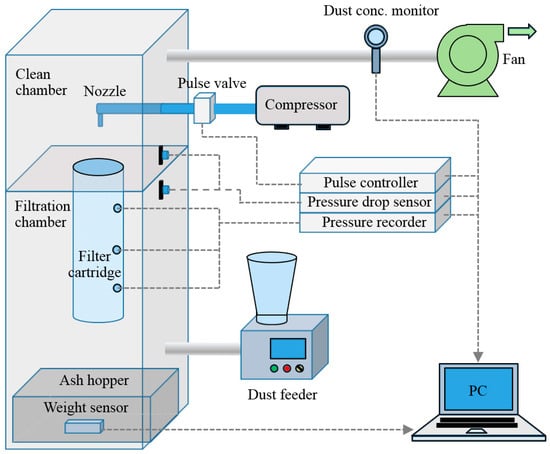
Figure 1.
This is a figure. Schemes follow the same formatting.
2.2. Filter Cartridge, Nozzle, and Dust
Figure 2 shows the structure schematic and physical diagram of the pleated cone filter cartridge, annular-slit nozzle, and venturi tube. The pleated cone filter cartridge is a typical pleated filter cartridge with an inner cone filter surface. The inner cone filter surface is a conically pleated filter material structure and has a metal cone at the top. The filter cartridge has a height of 660 mm, an outer diameter of 320 mm, and an inner diameter of 240 mm. It has a pleat depth of 40 mm and a pleat number of 120. The bottom diameter of the inner cone filter part is 200 mm, the inner cone height is 760 mm, and it has a pleat depth of 18 mm with a pleat number of 60. The filter material is polytetrafluoroethylene, and its thickness is 0.6 mm.
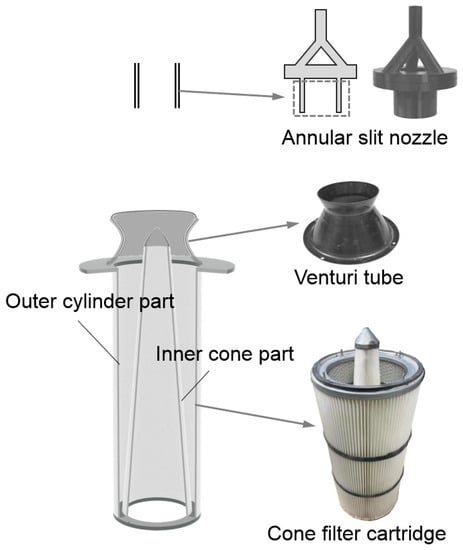
Figure 2.
Schematic diagrams and photographs of cone filter cartridge, the annular-slit nozzle, and Venturi tube.
The outlet of the slit nozzle is designed as an annular opening, with a diameter of 92 mm for the inner ring and 95.34 mm for the outer ring, and the slit and common nozzles have the same area. The Venturi tube in the apparatus has a height of 120 mm and features a throat with a diameter of 110 mm. The diameter of the opening for the upper section is 136 mm, and for the lower section is 210 mm.
Experimental tests were conducted using K brand industrial talc powder (1250 meshes), with D10, D50, and D90 of 0.42 µm, 0.83 µm, and 2.06 µm, respectively.
2.3. Experimental Procedures
This experiment consists of two procedures: off-line pulse injection and on-line dust filtering and cleaning. In the on-line dust filtration-ash cleaning experiment, dust removal and ash cleaning processes are included.
- (1)
- Off-line pulse jet cleaning procedure
Under the condition that the fan is not running and no dust is being added, the filter cartridge is subjected to pulse jetting. During the jetting process, high-pressure compressed air rapidly enters the filter cartridge and draws ambient air into it.
There are three observation points located on the inner wall of the filter cartridge. The distance between measuring points P1 and the cartridge top opening, as well as the distance between P3 and the cartridge bottom, is 110 mm. While measuring point P2 is situated in the cartridge middle. The results of the pulsed-jet pressure at the three observation points are recorded using high-frequency pressure sensors with a frequency of 500 Hz. The variation in pressure at each observation point is compared for the common and slit nozzles at a jet distance of 200–700 mm, while also investigating the initial compressed air pressure of 0.3–0.6 MPa. The pulse duration is 0.15 s. To ensure result reliability, we repeated each experiment set five times.
- (2)
- Online dust filtration and filter cleaning
During the filtration process, dusty gas is suctioned by the fan and enters the dust collector through the lower inlet. Dust is retained on the outer surface of the filter cartridge due to screening, interception, and other factors in the filtration chamber. The purified airflow exits through the dust collector outlet. The air volume of the dust collector system can be controlled by adjusting the speed of the fan using a frequency converter. As dust accumulates on the surface of the filter cartridge, a dust cake with a particular thickness is formed that increases the pressure drop of the filtration airflow. The pulse jet technology is used to clean the dust on the surface of the filter cartridge (in this study, the experiment was conducted in a clean-on-time mode where the dust cleaning interval was set to 20 min). During pulsed-jet cleaning, high-pressure compressed air, inducing the surrounding air, rapidly enters the filter cartridge core. The dust deposited on the surface of the filter cartridge is influenced by the airflow and falls into the ash hopper.
The Incoming airflow has a volume of 330 m3/h and a dust concentration of 5 g/m3. The filtration velocity is 1.20 cm/s. During the experiment, we measured both the pressure drop across the filter cartridge (inside and outside) and the mass of dust collected in the ash hopper. For each case, the pressure drop and the mass of dust that had fallen off are recorded with a frequency of 1 Hz using a computer from the onset until the end in real time.
3. Results and Discussion
3.1. Comparison of Pulsed-Jet Pressure between the Annular-Slit Nozzle and the Common Nozzle Cases
This section compares the pressure change over time in the cartridge for the common nozzle and the slit nozzle cases. The initial compressed air pressure was 0.30, 0.45, and 0.60 Mpa, with a jet distance of 400 mm and a pulse duration of 0.15 s. Figure 3 and Figure 4 illustrate this comparison.

Figure 3.
Pressure variation with time of observation points (a) P1, (b) P2, and (c) P3 in common nozzle case.

Figure 4.
Pressure variation with time of observation points (a) P1, (b) P2, and (c) P3 in slit nozzle case.
According to previous literature and the results of this experimental study, the pulse jet airflow in the filter cartridge could be divided into five stages.
Stage 1: Generation of a static pressure pulse wave when the jet starts. When the pulsed jet is triggered, it generates a static pressure pulse wave that quickly propagates through the air at the speed of sound. This results in an increase in static pressure at each observation point in the cartridge [19], but this pressure is relatively low.
Stage 2: Entrainment of surrounding air by the jet. As the jet exits the nozzle and enters the region above the cartridge, it entrains the ambient air, reducing the jet velocity and increasing the flow flux.
Stage 3: Formation of negative pressure in the filter cartridge. The cone prevents the jet airflow from entering the filter cartridge directly, instead, it collides with the cone, causing the airflow to diffuse, weaken the dynamic pressure, and enhance the static pressure. After entering the filter cartridge, the jet continues to produce an entrainment effect. The limited inner space of the filter cartridge and relatively low air permeability of the cartridge makes it difficult for outside air to flow in, causing negative pressure within the cartridge.
Stage 4: The pulse jet rebounds and the pressure accumulates. The dynamic pressure energy of the jet airflow converts into static pressure energy upon hitting the cartridge bottom, accumulating from the lower to the upper section. This creates a static pressure spatial distribution pattern in which the bottom has high pressure and the upper section has low pressure [20]. The positive peak value of static pressure is commonly used as an index to assess the strength of pulsed-jet pressure. Thus, the pressure accumulation during stage 4 is crucial in determining the effectiveness of pulse injection for cleaning the filter cartridge.
Stage 5: Ending with negative pressure. After the pulse jet is complete, the accumulated static pressure in the filter cartridge dissipates outward, creating negative pressure within the cartridge due to inertia.
The pressure period was nearly the same between the common and slit nozzle cases, but their spatial pressure distribution differed. In comparison to the common nozzle case, the case with the slit nozzle exhibited a substantially higher pulsed-jet pressure at the top of the cartridge as well as significantly increased pressure in the upper and middle sections. The annular slit nozzle has a longer circumferential length of the nozzle exit in contact with surrounding air (588.5 mm in total, consisting of inner and outer edges of the annular) compared to only 78.5 mm for the common round hole nozzle with the same exit cross-sectional area, the air entrainment caused by the annular slit jet was greater. When using the slit nozzle, the contact surface between the jet and surrounding air, including the air in the central space of the slit nozzle, was notably increased, thus augmenting air entrainment and resulting in increased air pressure within the filter cartridge.
Furthermore, the pressure changed over time in the cartridge and was compared using both the common and slit nozzles. The tests were conducted at an initial compressed air pressure of 0.45 MPa, a jet distance range of 200–700 mm, and a pulse duration of 0.15 s, as illustrated in Figure 5.
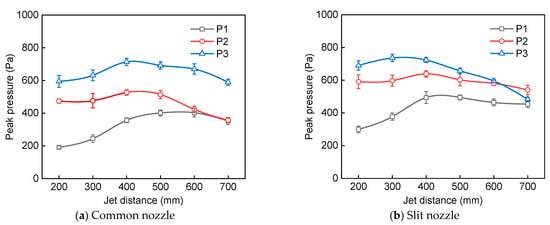
Figure 5.
Peak pressures at observation points with the jet distance in (a) the common nozzle case and (b) slit nozzle case.
As the jet distance increased, the pressure at observation points P1, P2, and P3 initially increased and then decreased in both nozzle cases. From the results, it can be concluded that, in general, the pressure recorded at P3 was higher than at P2 and P1. However, it should be noted that in the case of the slit nozzle with a jet distance of 700 mm, the pressure at P2 was higher than at both P3 and P1. The reason is that as the distance between the jet and the cartridge opening increases, the space for the surrounding air induced by the jet airflow also increases, resulting in the suction of more airflow. When the jet distance is too large, the jet airflow gradually diffuses, and some of the airflow fails to enter the filter cartridge, leading to a loss of airflow and a decrease in pulsed-jet pressure at each observation point.
At the same jet distance, both the common and slit nozzle cases exhibited large peak pressure at the bottom measuring point, P3, and small pressure at the upper section, P1. Additionally, the slit nozzle had a generally larger peak pressure at each measuring point compared to the common nozzle. In particular, the peak pressure value at the upper section of the filter cartridge is larger than that in the common nozzle case, especially at a small jet distance (≤400 mm). At jet distances of 200 mm, 300 mm, and 400 mm, the peak pressure at P1 in the slit nozzle case increased by 56%, 54%, and 38%, respectively, when compared to the common nozzle.
As shown in Figure 6, the pulsed-jet intensity and uniformity, which are calculated from the average values and coefficients of variation of peak pressures at the observation points [19,21], are influenced by the jet distance for both the common and slit nozzle cases. When the jet distance increased, the pulsed-jet intensity initially increased and then decreased, while the pulsed-jet uniformity improved.
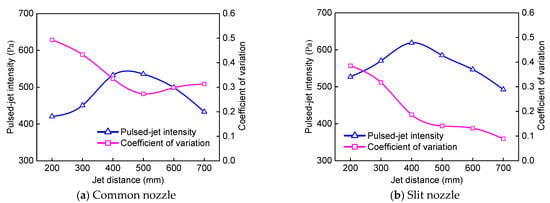
Figure 6.
Variation of pulsed-jet performance with jet distance in (a) the common nozzle case and (b) slit nozzle case.
For both the common nozzle and slit nozzle cases, the pulsed-jet intensity initially increased and subsequently decreased as the jet distance increased. Regarding the common nozzle, the maximum pulsed-jet intensity was 536 Pa at a jet distance of 500 mm. The corresponding coefficient of variation was 0.27. For the slit nozzle, the pulsed-jet intensity reached its highest value of 619 Pa at a jet distance of 400 mm, with the corresponding variation coefficient of 0.19. The pulsed-jet intensity was 16% greater than optimally achieved with the common nozzle. Furthermore, the pulsed-jet uniformity was 44% higher, as indicated by the reduced variation coefficient. In order to improve the pulsed-jet cleaning performance, it is necessary to choose an appropriate jet distance to ensure full coverage of the treated area by the airflow. This will prevent premature loss of kinetic energy of the jet flow, thereby optimizing the performance of the pulsed-jet filter cartridge.
From these results, it can be concluded that the jet produced by the slit nozzle has a larger contact area with the surrounding air. This enhances the entrainment effect, and therefore, improves the pulsed-jet pressure. The annular jet entrains the central air flow, creating negative pressure that causes the jetting airflow to concentrate at the center. If the jet distance is too small, entrainment is reduced. If the jet distance is too large, part of the jet airflow cannot enter the filter cartridge core, causing air flow loss (as Figure 7 illustrates).
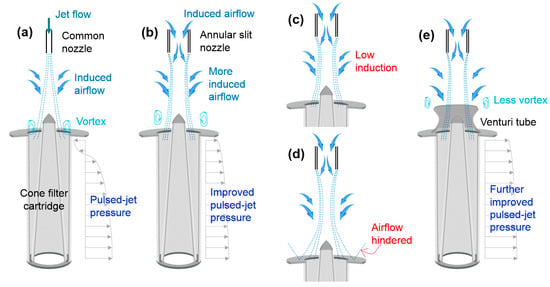
Figure 7.
Mechanism of the pulsed-jet cleaning (a) in common nozzle case; (b) in annular-slit nozzle case, (c) with small jet distance, (d) with large jet distance (e) with a Venturi tube.
3.2. Effect of Venturi on Pulsed-Jet Pressure and Performance
The pressure change in the filter cartridge over time was compared under the conditions of an initial compressed air pressure of 0.45 Mpa, a jet distance of 400 mm, and a pulse duration of 0.15 s for both the common nozzle and slit nozzle after adding a Venturi tube, as depicted in Figure 8.
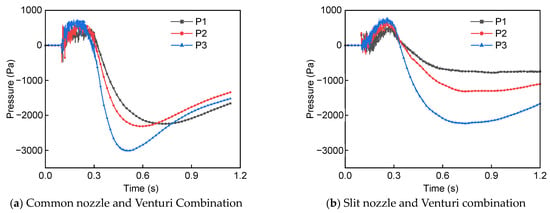
Figure 8.
Change of pressure at observation points with time in (a) the case of common nozzle and Venturi combination and (b) the case of slit nozzle and Venturi combination.
When a Venturi tube was installed, the top of the filter cartridge showed that the slit nozzle had a more pronounced optimization effect compared to the common nozzle.
As shown in Figure 9, the pulsed-jet intensity in the Venturi-equipped slit nozzle case was 655 Pa, which was 8% higher than that in the Venturi-equipped common nozzle case. The common nozzle with the Venturi tube experienced an increase in pulsed-jet intensity by 14%, whereas the slit nozzle with the Venturi tube experienced an increase in injection intensity by 6%. The Venturi tube significantly improved the pulsed-jet intensity and uniformity.
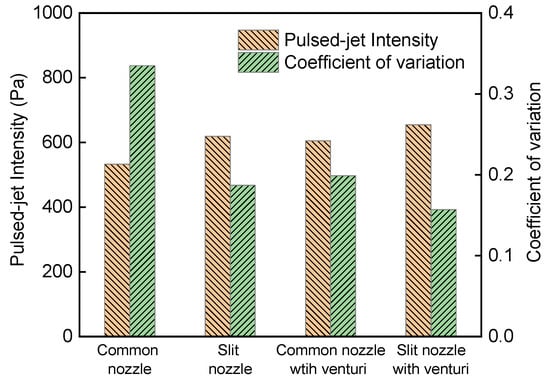
Figure 9.
Comparison of the pulsed-jet performance between the common nozzle and the annular-slit nozzle cases.
The efficiency of the Venturi tube is attributed to the acceleration of jet airflow, creating a negative pressure area outside the tube. This strengthens the surrounding air entrainment [22]. Moreover, the Venturi tube is advantageous in converting the dynamic pressure of the pulse jet flow into static pressure inside the filter cartridge, delaying air outflow and prolonging the action time of the jet airflow. This increases the side wall pressure [7]. According to Bi et al. [11], the addition of the Venturi tube notably raises the maximum side wall peak pressure at the lower section of the filter bag and the maximum reverse acceleration on the entire filter bag, effectively enhancing the pulsed-jet cleaning intensity.
3.3. Online Dust Filtration and Filter Cleaning Experiment
Furthermore, an online dust filtration and filter cleaning experiment was conducted in four cases, as presented in Figure 10. A cleaning-on-time mode was implemented, and the pulsed-jet cleaning was conducted every 20 min with a total of 18 cleaning cycles experienced. The study analyzed the pressure drop between the inside and outside of the filter cartridge, and the change in fallen dust mass over time was compared for each case.
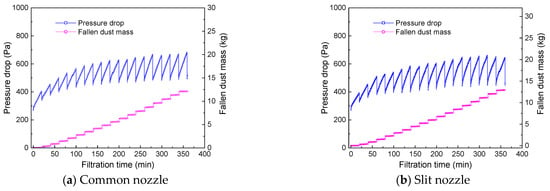
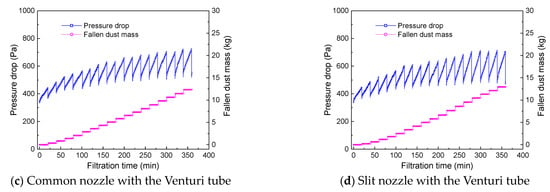
Figure 10.
Filtration pressure drop over time in cases of (a) the common nozzle, (b) the annular-slit nozzle, (c) common nozzle with the Venturi tube, and (d) slit nozzle with the Venturi tube.
In all four cases, the pressure drop increased gradually during dust filtration, and the initial pressure drop was similar. Following pulsed-jet cleaning, there is an immediate reduction in pressure drop, although it remained higher than the initial pressure drop of the current cycle. This indicates that the pulsed-jet cleaning process removed some of the dust from the cartridge, but residual dust remained. Additionally, the use of the Venturi tube resulted in an increased pressure drop. This is primarily due to the narrow space between the Venturi tube and the cone, which creates a relatively high level of local air resistance.
The residual pressure drop in the slit nozzle case was generally smaller than that in the common nozzle case under the same filtration time, whether or not the Venturi tube was installed.
When the Venturi tube was not installed, the residual pressure drop increased from 339 Pa to 495 Pa after 18 rounds of cleaning. The residual pressure drop increased to 444 Pa when using the slit nozzle. The average residual pressure drop in the slit nozzle case was 413 Pa, which was 8% lower than the average residual pressure drop in the common nozzle case.
After 18 cleaning cycles, the residual pressure drop increased to 519 Pa for the common nozzle and 472 Pa for the slit nozzle with the Venturi installed. The average residual pressure drop of the slit nozzle was 444 Pa, which was 6% lower than that of the common nozzle and the Venturi combination.
The results suggest that the pulsed-jet performance with the slit nozzle is better than that with the common nozzle, and the addition of a Venturi tube further enhances the cleaning effect of the filter cartridge.
Upon observing the fallen dust mass in the ash hopper, it could be that the accumulated fallen dust mass gradually increased during dust filtration, and the dust mainly adhered to the outer wall of the filter cartridge. When the pulsed-jet cleaning was activated, the dust that was stuck to the outer wall of the filter cartridge was detached, causing a sudden rise in the amount of dust that fell into the ash hopper.
The fallen dust mass produced by a single cleaning of the slit nozzle without a Venturi tube was 0.64 kg, which was 6% higher than that of the common nozzle. When the slit nozzle with a Venturi tube was installed, the average value of the fallen dust mass during a single cleaning was 0.71 kg, which was 11% higher than that of the common nozzle with the Venturi tube. The results demonstrate that the slit nozzle and Venturi tube can make more dust fall off from the filter cartridge, resulting in a significant improvement in the dust-cleaning effect of the dust collector.
To comprehensively evaluate the effect of the slit nozzle and Venturi tube on the cleaning performance, this study introduces the comprehensive filtration performance index (QF), which considers the dust removal rate, energy consumption of dust filtration and ash cleaning. The physical interpretation of QF is the amount of dust removed per unit of time, realized through the unit energy consumption per unit of time. A higher QF value indicates better comprehensive filtration performance [23]. The formula for calculating QF is:
where Cin and Cout are dust emission concentration at inlet and outlet, mg/m3; is mean filtration pressure drop, Pa; Q is filtration air volume, m3/s; P0 and P1 are compressed air pressure before and after pulse jet, Pa; Vt is air tank volume, m3; n is jet times; t is time, s.
Comparison of QF in each case is displayed in Figure 11. In the absence of a Venturi tube, the QF of the slit nozzle was 0.18, which was 7% higher than that of the common nozzle. When the Venturi tube was installed, the QF of the slit nozzle was 0.17, which was 5% higher than that of the common nozzle. This indicates that the slit nozzle can effectively enhance the comprehensive filtration performance of the dust collector. It is important to note that although the addition of a Venturi tube enhances the dust-cleaning performance of the filter cartridge to a certain extent, it also increases the operating resistance of the dust collector. As a result, there is an increase in the energy consumption of the equipment and a decrease in the comprehensive filtration performance.
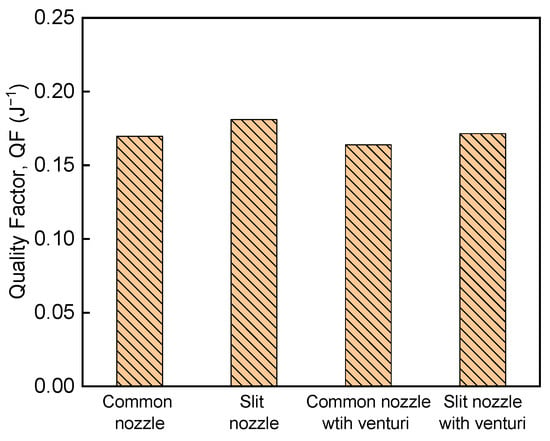
Figure 11.
Comparison of comprehensive filtration performance (QF).
4. Conclusions
This study investigated the impact of a slit nozzle on the performance of a pulsed jet for a cone filter cartridge in offline pulse jet and online dust filtration and filter cleaning experiments. We examined the impact of initial compressed air pressure, jet distance, and Venturi tube on the pulsed-jet cleaning performance. The primary findings can be summarized as:
- (1)
- For both the common and slit nozzle cases, five stages of the pulse jet process were summarized, which included the generation of a static pressure pulse wave when the jet starts, the entrainment of surrounding air by the jet, the formation of negative pressure in the filter cartridge, the accumulation of the rebound jet, and finally the ending with negative pressure. The static pressure in the fourth stage played a vital role in the filter cleaning through the pulse jet. Compared to the common nozzle, the jet generated by the slit nozzle had a significantly larger contact area with the surrounding air. This enhancement led to an improved entrainment effect, increased overall pulsed-jet pressure and significantly enhanced pressure in the upper and middle sections of the filter cartridge, especially the upper one.
- (2)
- The pulsed-jet intensity initially increased and then decreased with the increase in jet distance in both the common and the slit nozzles. The entrainment decreased with the decrease in the jet distance, while an excessive jet distance caused some of the jet airflow to fail to enter the filter cartridge. The optimal jet distance for the common nozzle and slit nozzle were 500 mm and 400 mm, respectively. At the optimal jet distance, the pulsed-jet intensity with the slit nozzle was increased by 16% (the pressure in the upper region is increased by 23%), and the pulsed-jet uniformity was increased by 44% compared with the common nozzle. For the slit nozzle, the pulsed-jet intensity was further increased by 6% after adding a Venturi tube, and pulsed-jet uniformity also improved.
- (3)
- Compared with the common nozzle, the slit nozzle could reduce the residual pressure drop of the dust collector and increase the fallen dust mass. The fallen dust mass produced by a single cleaning of the slit nozzle was 0.64 kg. The average residual pressure drop decreased by 8% (to 413 Pa), while the dust quality and the comprehensive filtration performance increased by 6% and 7% (to 0.18), respectively. When using a slit nozzle, the addition of a Venturi tube improved the cleaning effect of the filter cartridge. However, this also resulted in an increase in the filtration pressure drop of the dust collector, leading to a reduction in the comprehensive filtration performance.
Author Contributions
Conceptualization, Z.X., G.W., J.G. and W.L.; software, Y.Z.; data curation, writing—original draft preparation, Y.Z. and Q.W.; writing—review and editing, Z.X., G.W., J.G., W.L., Q.W. and J.L.; validation, Q.W.; supervision, Q.W. and J.L.; funding acquisition, Z.X. and J.L. All authors have read and agreed to the published version of the manuscript.
Funding
This work was supported by the National Natural Science Foundation of China (52064037) and the Cultivating Project for Academic and Technical Leader of Key Discipline of Jiangxi Province (20225BCJ23027).
Institutional Review Board Statement
Not applicable.
Informed Consent Statement
Not applicable.
Data Availability Statement
Not applicable.
Conflicts of Interest
The authors declare no conflict of interest. The funders had no role in the design of the study; in the collection, analyses, or interpretation of data; in the writing of the manuscript, or in the decision to publish the results.
References
- Lelieveld, J.; Evans, J.S.; Fnais, M.; Giannadaki, D.; Pozzer, A. The contribution of outdoor air pollution sources to premature mortality on a global scale. Nature 2015, 525, 367–371. [Google Scholar] [CrossRef]
- Tu, X.; Fang, X.; Fang, H.; Ye, C.; Liu, Z.; Jia, X.; He, D.; Wang, J.; Huang, H.; Zou, C.; et al. Chemical composition characteristics and source apportionment of PM2.5 in ceramic industrial base during winter. Aerosol Air Qual. Res. 2022, 22, 210390. [Google Scholar] [CrossRef]
- McDuffie, E.E.; Martin, R.V.; Spadaro, J.V.; Burnett, R.; Smith, S.J.; O’Rourke, P.; Hammer, M.S.; van Donkelaar, A.; Bindle, L.; Shah, V.; et al. Source sector and fuel contributions to ambient PM(2.5) and attributable mortality across multiple spatial scales. Nat. Commun. 2021, 12, 3594. [Google Scholar] [CrossRef] [PubMed]
- Wang, D. Mine Dusts; Science Press: Beijing, China, 2015. (In Chinese) [Google Scholar]
- Zhang, M.; Qin, W.; Ma, X.; Liu, A.; Yan, C.; Li, P.; Huang, M.; He, C. An environmentally friendly technology of metal fiber bag filter to purify dust-laden airflow. Atmosphere 2022, 13, 485. [Google Scholar] [CrossRef]
- Li, S.; Wen, G.; Lv, W.; Liu, H.; Lin, Y.; Yuan, L.; Zhou, F. Effects of various humid environments on the filtration and dust cleaning performance of filter media. Sep. Purif. Technol. 2022, 309, 122940. [Google Scholar] [CrossRef]
- Li, J.L.; Chen, Y.Z.; Lin, Z.J.; Wu, Q.Q.; Wu, D.S. Study progress and outlook of pulsed-jet cleaning technology for filter cartridge of dust collector. Metal Mine 2022, 557, 23–35. (In Chinese) [Google Scholar]
- Zhang, Q.; Qian, Y.L.; Liu, D.; Zhang, Y.Y. Experimental study on the influence of venturi on filter cartridge cleaning of a pulse-jet filtration system. Environ. Sci. Technol. 2015, 38, 133–137. (In Chinese) [Google Scholar]
- Feng, X.; Geng, F.; Teng, H.; Li, S.; An, J.; Gui, C. Dust dispersion during the pulse-jet cleaning process with the diffuser effect of the cartridge filter. Environ. Sci. Pollut. Res. Int. 2023, 30, 41486–41504. [Google Scholar] [CrossRef]
- Liu, X.; Shen, H. Effect of venturi structures on the cleaning performance of a pulse jet baghouse. Appl. Sci. 2019, 9, 3687. [Google Scholar] [CrossRef]
- Bi, Y.X.; Zhang, M.X.; Chen, J.D.; Chen, H.Y.; Qian, Y.L.; Zhou, R. Influence of venturis on bag cleaning of a pulse-jet filtration system. Chin. J. Environ. Eng. 2013, 7, 4481–4485. (In Chinese) [Google Scholar]
- Qiu, J.; Wu, D.; Chen, D.; Li, J. Reverse pulsed-flow cleaning of pleated filter cartridges having an inner pleated filter cone. Process Saf. Environ. 2021, 146, 481–489. [Google Scholar] [CrossRef]
- Chen, S.; Chen, D. Annular-slit nozzles for reverse flow cleaning of pleated filter cartridges. Sep. Purif. Technol. 2017, 177, 182–191. [Google Scholar] [CrossRef]
- Shuo, Z.; Zhihong, T.; Libing, L.; Guilong, X. The influence of the pulse jet flow on the dust cleaning characteristics of filter cartridges with double Laval nozzles. Environ. Pollut. Control. 2021, 43, 411–415. (In Chinese) [Google Scholar]
- Xi, Y.; Jiang, W.W.; Dai, Y.; Wang, G.J.; Yan, Z.G.; Ren, F.L.; Niu, F.J. Numerical simulation and optimal of conical diffuser for ash removal characteristics based on CFD. Light Ind. Mach. 2021, 39, 98–103. (In Chinese) [Google Scholar]
- Xue, F.; Li, P.; Huang, W.; Hu, M.; Yan, C.; Chen, H.; Yang, G. Effect of nozzle form to filter cartridge pulse-jet cleaning performance in clean-on-demand mode. China Powder Sci. Technol. 2022, 28, 48–56. (In Chinese) [Google Scholar]
- Zhu, Y.; Zuo, D.; Yang, X.G.; Yan, H.F.; Long, X.P.; Ji, B. Numerical simulation of the pulsejet backblow ash removal process of a combined cartridge filter. Fluid Mach. 2020, 48, 23–28. (In Chinese) [Google Scholar]
- Su, Z.; Lin, Z.; Li, J.; Qiu, J.; Wu, Q.; Wu, D. Numerical simulation of the performance of pulse jet dust cleaning of venturi nozzle improved golden cone filter. Chin. J. Environ. Eng. 2022, 16, 220–229. (In Chinese) [Google Scholar]
- Li, J.; Wang, P.; Wu, D.; Chen, D. Numerical study of opposing pulsed-jet cleaning for pleated filter cartridges. Sep. Purif. Technol. 2020, 234, 116086. [Google Scholar] [CrossRef]
- Li, J.; Li, S.; Zhou, F. Effect of cone installation in a pleated filter cartridge during pulse-jet cleaning. Powder Technol. 2015, 284, 245–252. [Google Scholar] [CrossRef]
- Li, J.; Wu, D.; Wu, Q.; Luo, M.; Li, J. Design and performance evaluation of novel colliding pulse jet for dust filter cleaning. Sep. Purif. Technol. 2019, 213, 101–113. [Google Scholar] [CrossRef]
- Li, J.; Zhao, Y.; Sun, Z.; Wu, Q.; Zhong, Y.; Wu, Q.; Ma, Z.; Wu, D. Numerical simulation of improved pulse jet performance by annular slit nozzle for the filter cartridge with an inner cone deflector. J. Nanchang Univ. (Eng. Technol.) 2023, 45, 9–15. (In Chinese) [Google Scholar]
- Li, J.; Zhou, F.; Li, S. Experimental study on the dust filtration performance with participation of water mist. Process Saf. Environ. 2017, 109, 357–364. [Google Scholar] [CrossRef]
Disclaimer/Publisher’s Note: The statements, opinions and data contained in all publications are solely those of the individual author(s) and contributor(s) and not of MDPI and/or the editor(s). MDPI and/or the editor(s) disclaim responsibility for any injury to people or property resulting from any ideas, methods, instructions or products referred to in the content. |
© 2023 by the authors. Licensee MDPI, Basel, Switzerland. This article is an open access article distributed under the terms and conditions of the Creative Commons Attribution (CC BY) license (https://creativecommons.org/licenses/by/4.0/).